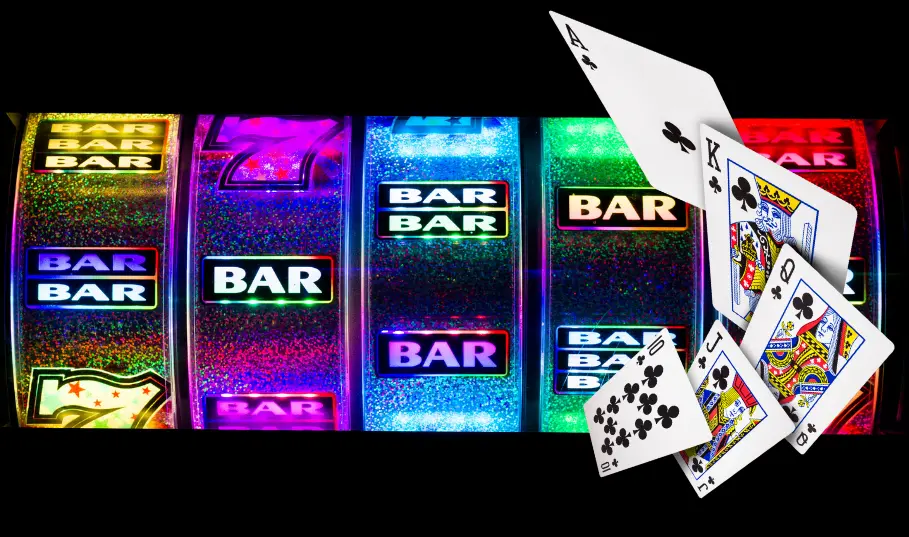In poker, a Straight is a simply a five-card hand that consists of consecutive numerical cards regardless of their suits. Here’s a factual representation of a Straight using card symbols:
A♠ K♦ Q♥ J♣ 10♠
In this example, the cards form a Straight because they are in sequential order: Ace (A), King (K), Queen (Q), Jack (J), and 10. It’s important to note that the suits (Spades, Diamonds, Hearts, Clubs) don’t matter when determining a Straight; only the numerical sequence of the cards matters. A Straight can start from any rank, such as 5♣ 4♥ 3♠ 2♦ A♣ or go all the way up to 10♥ 9♦ 8♠ 7♣ 6♠. The highest possible Straight is A♠ K♦ Q♥ J♣ 10♠ (we call this Broadway, and it’s the highest straight you can get in poker ), and the lowest is A♣ 2♦ 3♠ 4♥ 5♣ (a wheel or bicycle).
In poker hand rankings, a Straight typically ranks fifth out of all possible hands. While it’s not as powerful as a Flush, Full House, Four-of-a-Kind, or Straight Flush, straights can still win big pots if played strategically. In fact, making a straight in Texas Hold’em
If you want to try playing poker to make money or simply for fun, you have several options to choose from:
- Playing live poker at your local casino. Smallest cash game stakes usually start from $1/2 with Texas Hold’em being the most popular game played. If you compare live poker to online, similar stakes are almost always much softer and easier to beat.
- Playing live poker in a home game. These games can be really fun and profitable if you have access to them through your connections or get invited to a game!
- Playing at various online poker sites dedicated solely to multiple poker formats like NLHE, PLO, PLO6, Mixed Games etc. You can find a wide range of stakes starting all the way from $0.01/0.02 up to $500/1000, sometimes even bigger than that.
- Researching the best poker online casinos. These sites are guaranteed to provide you with accurate probabilities of winning in slots through verified RNGs. If you try your luck at the poker tables, you should expect no foul play when you are looking for that sweet poker straight hand, as long as the site is licensed and takes proper security measures!
Poker Straight Odds and Probabilities
Knowing your math is crucial to succeeding in poker long-term. Understanding the odds when drawing to a straight can make all the difference between a winning and losing session.
In a standard 52-card deck, there are precisely 10,200 distinct ways to form a Straight. This might seem like a lot, but it’s essential to consider the context of the game and your hole cards. For example, in Texas Hold’em, you receive two hole cards, and five community cards are dealt. To make a Straight, you’ll typically need to use at least one of your hole cards in conjunction with the community cards.
In Texas Hold’em, where you’re tasked with making the strongest possible five-card hand out of seven total cards (two hole cards and five community cards), your chances of forming a Straight when all five community cards are on the board are about 4.62%. This translates to odds of approximately 20.6-to-1 against drawing a Straight.
- Completing a Gutshot Straight Draw (Four Outs): Turn Probability: The probability of completing a gutshot straight draw on the turn is approximately 8.51%.
- River Probability: If you didn’t complete your straight on the turn, the probability of completing it on the river increases to approximately 8.70%.
- Completing an Open-Ended Straight Draw (Eight Outs): Turn Probability: The probability of completing an open-ended straight draw on the turn is approximately 16.04%.
- River Probability: If you didn’t complete your straight on the turn, the probability of completing it on the river increases to approximately 16.52%.
- Completing a Straight Flush (Four Outs): Turn Probability: The probability of completing a straight flush on the turn is approximately 0.18%.
- River Probability: If you didn’t complete your straight flush on the turn, the probability of completing it on the river remains approximately 0.18%.
If you want to learn more, we have an extensive beginner’s guide to poker you should check out.
Optimal Poker Strategy when drawing to Straights
Drawing for straights in Texas Hold’em can be a crucial aspect of your overall poker strategy, and it varies between cash games and tournament play. In this guide, we’ll explore efficient strategies for drawing to straights in both formats.

Straights in Cash Games
Cash game players are more willing to gamble and provided the pot odds and implied odds add up, you will see more players put money in the pot in cash games on a draw compared to tournament players (where the object is usually survival unless you have a big stack to bully other players). Here’s the optimal Cash Game Straight strategy:
Calculate Pot Odds
Before committing chips to a straight draw, calculate your pot odds. To do this, compare the size of your bet to the total size of the pot, including your opponent’s bets. If the potential reward (the pot odds) exceeds the cost of your bet, it can be profitable to chase your straight.
Example: You’re playing No-Limit Texas Hold’em with $100 stacks, and the pot is $20. You need one more card for your straight draw, and your opponent bets $10. Your pot odds are ($10 + $20) / $10 = 3:1. If your odds of completing the straight are better than 3:1, it’s a favorable call.
Consider Implied Odds
In cash games, you also need to factor in implied odds. These include potential future bets if you complete your straight and extract more value from your opponents.
Example: You’re holding 7♠8♠, and the flop comes 9♣10♦2♠. You have an open-ended straight draw. Your opponent bets $20 into a $30 pot. While your pot odds may not be favorable at this point, you anticipate that if you hit your straight on the turn or river, your opponent will likely bet again, potentially increasing the overall pot size. This additional value should be considered when deciding whether to call.
Be Aware of Board Texture
The texture of the community cards plays a huge role in decision-making. If the board is coordinated, meaning there are multiple cards in sequence or of the same suit, your straight draw becomes more valuable.
Example: The flop shows J♠Q♠2♣, and you hold K♦10♠. You have an open-ended straight draw and a flush draw. With such a coordinated board, your straight draw gains extra equity, making it a very strong draw, regardless of your opponents holdings.
Straights in Tournament Poker
In tournament poker, where the goal is to maximize your ROI by accumulating chips and surviving, drawing for straights requires a different approach:
Consider Chip Stack and Stage of the Tournament
Your chip stack relative to the blinds and antes should influence your decision to chase a straight draw. In the early stages, when you have a deeper stack, you can afford to speculate more. However, as blinds increase, your draws must have better odds to justify the risk, especially once approaching the bubble.
Take Risks Sparingly
When it comes to efficient strategies in poker tournaments, one of the guiding principles is about survival. Preserving your chip stack is vital, especially as you approach the bubble or final table. Be cautious about committing a significant portion of your stack to a straight draw unless the odds are heavily in your favor.
Use the Bubble to Your Advantage
Near the bubble, when players become more conservative to make it into the money, you can exploit their tight play by being more aggressive with your straight draws. They are less likely to call big bets unless they have strong made hands.
Example Hand from a Tournament
You’re in a poker tournament, and the blinds are increasing. You’re holding 9♠10♠, and the flop shows 7♣8♦K♠. You have an open-ended straight draw but are low on chips. In this situation, it may be best to fold and wait for a better opportunity to accumulate chips, especially if the pot odds aren’t favorable or you’re facing aggression. However, if your opponent seems to have a weak hand, you can try to steal the pot by semi-bluffing.
Poker Game Variations and Straights
While the principle of Straights across all types of poker remains the same, there are various nuances to consider when playing different games like Razz or 5-Card draw. Here are some of the main differences to consider:
Texas Hold’em
- In Texas Hold’em, a Straight consists of five consecutive cards from the player’s hand and the community cards.
- It’s essential to note that players can use any combination of their hole cards and the five community cards to make a Straight.
- Aces can serve as either the highest card in a ten-to-ace Straight or the lowest card in an ace-to-five Straight (also known as the “wheel”).
Seven-Card Stud
- Seven-Card Stud features a unique rule regarding Straights. Aces can only be used as high cards in this variation.
- The highest possible Straight in Seven-Card Stud is 10-J-Q-K-A of different suits.
- When forming Straights, players must consider the cards they have face-up and face-down. This adds an extra layer of strategy to creating a Straight.
Razz
- Razz is a lowball poker variant, and in this game, the lowest possible Straight is the best hand.
- The A-2-3-4-5 combination, often referred to as the “wheel,” is the best possible hand in Razz.
- In Razz, Straights don’t count against your hand, so the lower the cards, the better.
Omaha
- In Pot-Limit Omaha, players receive four-hole cards, and they must use exactly two of them in combination with three of the community cards to make a Straight.
- As with Texas Hold’em, Aces can be both high and low cards in Straights.
Five-Card Draw
- In Five-Card Draw, a Straight is formed by selecting five consecutive cards from the player’s hand.
- Aces can be used as both the highest card (A-K-Q-J-10) or the lowest card (A-2-3-4-5) in a Straight.
Short Deck Poker
- In Short Deck Poker, also known as Six-Plus Hold’em, Straights are easier to make because all the cards from 2 to 5 are removed from the deck.
- A Straight can be formed with any five consecutive cards, making it a more common hand in this variation.
Triple Draw Lowball
- In Triple Draw Lowball, Aces are considered high, so the lowest possible Straight is A-2-3-4-5.
- Players can draw new cards and improve their Straights over multiple drawing rounds.
What Is The Most Famous Straight in Poker History
Well, that’s a hard question to answer. Nevertheless, one of the most famous instances where a straight played a pivotal role in winning a substantial poker tournament comes from the 1987 World Series of Poker (WSOP) Main Event. This historic hand involved Johnny Chan and then-not-so-known player Erik Seidel. The details of this hand were made famous, as it was featured in the 1998 poker movie Rounders.
In this memorable hand, Johnny Chan held J9 suited and flopped a straight. Erik Seidel hit a top pair with a weak kicker, re-raising the flop against Chan’s bet. Chan called and the turn was a blank & went check-check. Chan’s trap was set, and Erik Seidel shoved all his chips in the middle on the river, getting snap-called by Chan with the nuts.
This real-life example underscores how a well-executed betting pattern with a flopped straight can lead to significant wins, elevating a player to legendary status. Your straight might not make you Johnny Chan, but using skill and optimal poker strategy, your straight can land you a monster pot!









